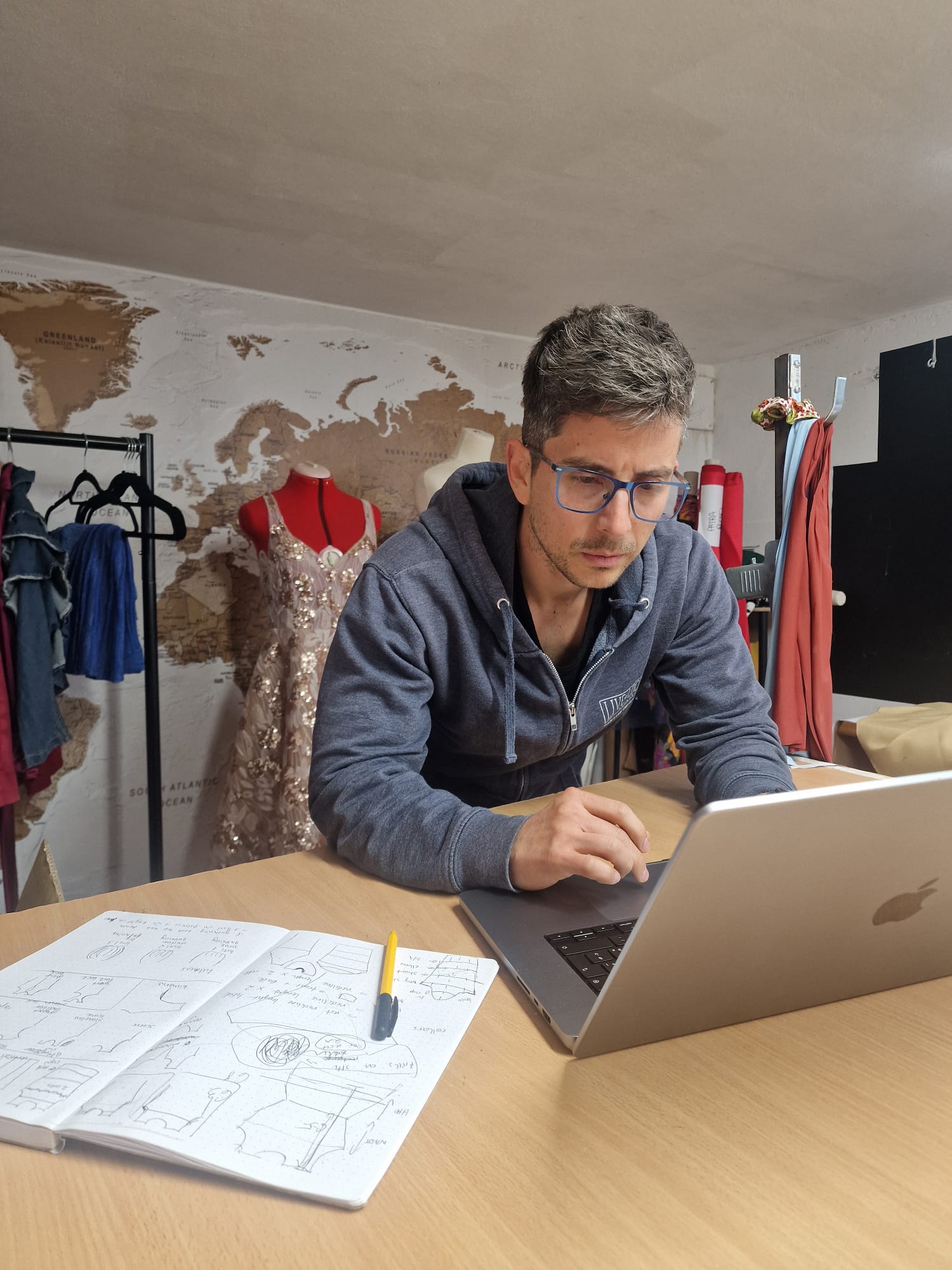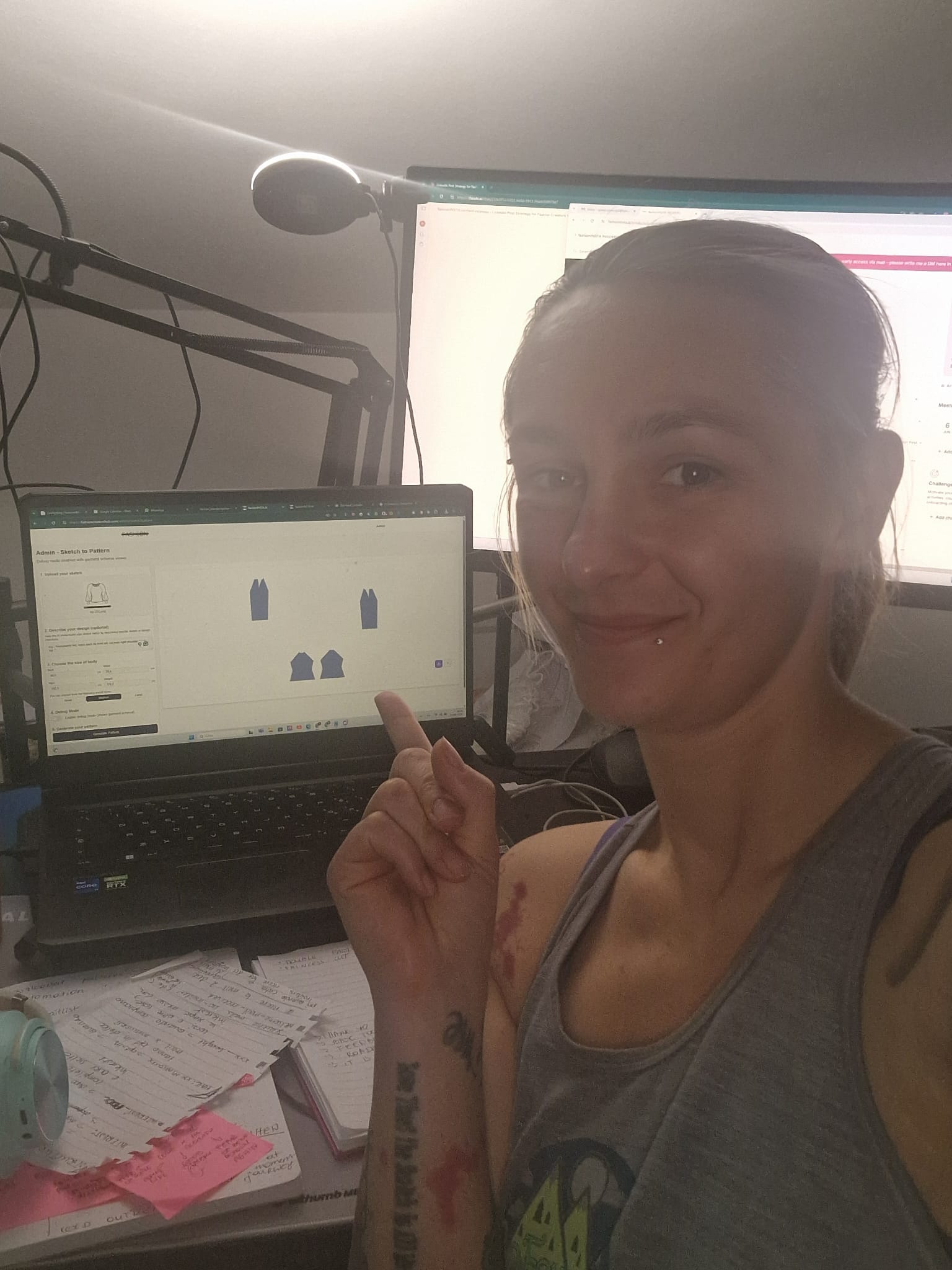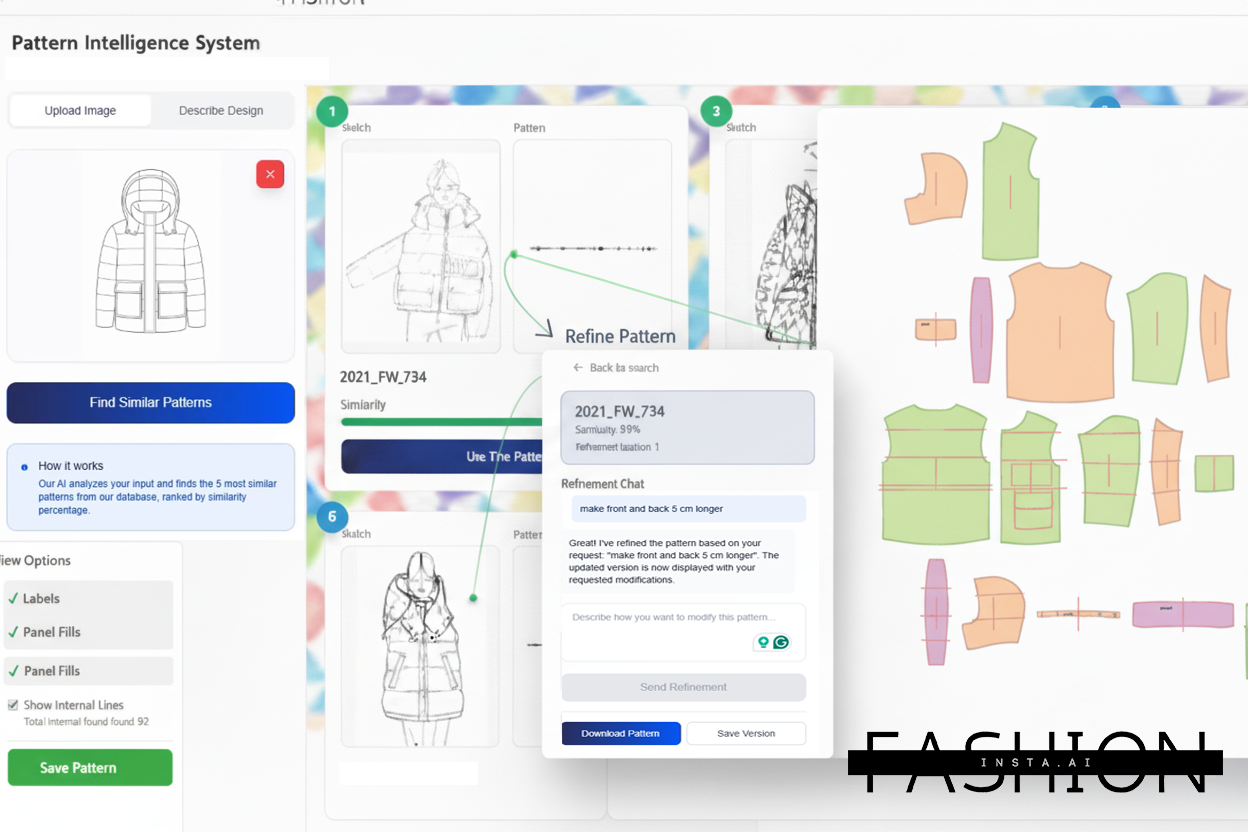Best AI pattern making tool 2025: how to match Zara's 15-day speed
Aug 07, 2025TL;DR: Max Mara meeting: Designer wants trending jacket in stores. Answer: 6 months. Zara does it in 15 days. They're not magic - they eliminated the pattern bottleneck. Traditional brands lose 2-4 weeks on patterns alone. fashionINSTA creates patterns in 10 minutes. Small brands can now match Zara's speed without the army.
I remember the exact moment I realized the fashion industry was broken.
I was sitting in a pattern-making meeting at Max Mara. The designer showed us a sketch of a jacket inspired by a street style photo she'd seen on Instagram that morning.
"When can we have this in stores?" she asked.
"Six months," came the reply.
Six months. To respond to a trend that would probably be dead in six weeks.
Meanwhile, Zara was pushing collections from canvas to store shelf in two weeks, bringing new designs from concept to store shelves in as little as 15 days. While we were still drafting patterns, they were already selling. That's when I understood something fundamental about the future of fashion. Speed isn't just an advantage anymore. It's survival. That's why I built fashionINSTA - an AI-powered sketch-to-pattern and pattern intelligence platform that eliminates the 2-4 week pattern bottleneck, creating production-ready patterns in 10 minutes instead of weeks.
Key Takeaways:
→ Zara's 15 days: Day 1-3 design, Day 4-6 patterns, Day 7-10 production planning, Day 11-14 manufacturing, Day 15 stores
→ Where brands fail: Pattern development (2-4 weeks), decision paralysis (80% pre-planned), communication delays (quarterly vs daily)
→ Traditional patterns: 10-17 days. fashionINSTA: 10 minutes. Upload sketch → generate pattern → export .DXF
→ Small brand advantages: No bureaucracy, direct manufacturer relationships, test smaller quantities, faster pivoting
→ Your system needs: Pattern generation (fashionINSTA), local sample makers (2-3 days), quick-turn manufacturers (7-14 days). Join 1200+ building rapid response
The 15-day timeline that changed everything
The term "fast fashion" was coined by the New York Times to describe Zara's mission to allow garments to go from the design stage to being sold in stores in just 15 days. But here's what most people don't understand about how they actually do it.
After products are designed, they take around 10 to 15 days to reach the stores. Let me break down their actual timeline:
→ Days 1-3: Trend identification and initial design
→ Days 4-6: Pattern development and prototyping
→ Days 7-10: Production planning and material sourcing
→ Days 11-14: Manufacturing and quality control
→ Day 15: Distribution to stores
The secret isn't magic. It's systematic speed at every single step.
Where traditional brands lose weeks
After 15 years in fashion, I've seen where the time really goes. An average piece of clothing for a major high street brand can take anywhere between three to six months to arrive in the shops.
Most brands get stuck in three places:
Pattern development bottleneck
Traditional pattern making takes 2-4 weeks per style. Fashion designers used to have around five weeks to finalize clothing designs before sending them to the pattern maker. However, now they have to speed up their work so they can produce new designs every single week.

Traditional pattern development combines digital tools with manual sketching and technical documentation.
While competitors are still drafting basic blocks, Zara is already cutting fabric.
Decision paralysis
Zara commits six months in advance to only 15 to 25 percent of a season's line. And it only locks in 50 to 60 percent of its line by the start of the season, meaning that up to 50 percent of its clothes are designed and manufactured smack in the middle of the season.
Most brands plan 80-90% of their collection months in advance. Zara plans half their collection while the season is happening.
Communication delays
Each Zara store sends daily sales reports to headquarters, providing valuable insights into which products are selling well and which are underperforming. Based on this data, the company adjusts production schedules accordingly. If a particular design proves successful, Zara can quickly replenish it, while slow-moving items are discontinued to avoid excess inventory.
While other brands wait for quarterly reports, Zara gets daily feedback from every store.
The technology advantage nobody talks about
Here's what changed the game for Zara: Zara's agile supply chain enables it to use shorter planning cycles (15-days instead of 30-days).
But the real breakthrough wasn't just IT systems. It was eliminating the pattern-making bottleneck.
The turnaround time is miraculous: as short as two weeks from an idea in a designer's head to a garment on a Zara store's shelf.
While Zara has armies of pattern makers working around the clock, you don't need armies. You need better tools.
Your 15-day timeline (without the army)
After building fashionINSTA, I've helped brands compress their timeline to match Zara's speed. Here's the new reality:
Day 1: Identify trend, create sketch→ Spot trending styles on social media → Create initial design concept → Define target customer and price point
Day 2: Generate patterns instantly→ Upload sketch to fashionINSTA (10 minutes per style) → Get production-ready patterns with seam allowances → Export .DXF files for immediate manufacturing

Modern AI tools can transform fashion sketches into production-ready patterns in minutes.
Days 3-4: Create samples with local manufacturer
→ Send patterns to quick-turn sample maker
→ Receive first samples for fit evaluation
→ Make minor adjustments if needed
Days 5-6: Fit, adjust, approve
→ Test fit on target demographic
→ Finalize construction details
→ Approve for production
Days 7-14: Production with quick-turn manufacturer
→ Cut and sew with pre-approved suppliers
→ Quality control during production
→ Prepare for distribution
Day 15: In stores or online
→ Launch with targeted social media campaign
→ Track sales data for future decisions
→ Begin planning next rapid response
The key isn't predicting trends. It's responding fast enough that prediction becomes irrelevant.
The small brand advantage
Here's something Zara doesn't want you to know: Zara's highly responsive, vertically integrated supply chain enables the export of garments 24 hours, 365 days of the year, resulting in the shipping of new products to stores twice a week.
But small brands have advantages Zara doesn't:
→ No corporate bureaucracy slowing decisions
→ Direct relationships with agile manufacturers
→ Ability to test with smaller quantities
→ Faster pivoting when trends change
One indie brand using fashionINSTA went from an Instagram trend to selling products in 18 days. They spotted a viral TikTok style, generated patterns the same day, and had samples within 72 hours.
Their first batch sold out in a week. Total investment? Less than $2,000.
The pattern development revolution
The biggest bottleneck for most brands isn't manufacturing. It's pattern development.
Traditional process:
→ Sketch interpretation: 2-3 days
→ Initial pattern draft: 3-5 days
→ First fitting: 2-3 days
→ Pattern corrections: 2-4 days
→ Final approval: 1-2 days
Total: 10-17 days just for patterns
fashionINSTA process:
→ Upload sketch: 2 minutes
→ Generate pattern: 8 minutes
→ Export for production: 30 seconds
Total: 10 minutes

AI-powered pattern systems can analyze sketches and generate technical patterns with refinement capabilities.
This isn't about replacing creativity. It's about eliminating the tedious technical work that kills speed.
Our users report complete collection development in under a week. Because when you can generate patterns in minutes instead of days, everything changes.
Why speed matters more than ever
In the conventional cycle, it used to take over a year from design to sales phase whereas in fast fashion the whole cycle is compressed down to only a week for each phase.
Now, with the rise of fast-fashion retailers, brands are expected to launch new collections multiple times a month.
The market has fundamentally changed. Customers expect constant newness. Social media drives instant trend cycles. Those that can't keep up are going out of business left and right.
Brands that can't keep up simply disappear.
The data that drives decisions
Each Zara store sends daily sales reports to headquarters, providing valuable insights into which products are selling well and which are underperforming. Based on this data, the company adjusts production schedules accordingly. If a particular design proves successful, Zara can quickly replenish it, while slow-moving items are discontinued to avoid excess inventory.
But you don't need Zara's infrastructure to be data-driven. Social media gives you real-time trend data. Your online sales give you immediate feedback. Customer comments tell you what's working.
The difference is having systems to respond quickly to that data.
Setting up your rapid response system
Here's how to build your own 15-day capability:
Technology infrastructure
→ Pattern generation: fashionINSTA for instant pattern creation
→ Communication: Direct lines to sample makers and manufacturers
→ Data tracking: Simple systems to monitor trends and sales
Supply chain partners
→ Local sample makers with 2-3 day turnaround
→ Quick-turn manufacturers within 7-14 days
→ Pre-negotiated pricing for rapid orders
Internal processes
→ Daily trend monitoring routine
→ Weekly decision-making meetings
→ Clear approval processes for rapid response
Financial planning
→ Reserve budget for trend-driven styles
→ Accept higher per-unit costs for speed
→ Plan for smaller initial quantities
The future belongs to the fast
Zara manages to "design, produce, distribute and sell its collections in [only] four weeks; a record-brief period if you take into account that its competitors take several months to complete this same process". But even 40 days is becoming too slow.
The playing field is leveling. Speed isn't just for giants anymore.
fashionINSTA is the number one tool for brands serious about rapid response. We're not just creating patterns faster. We're enabling an entirely new way of doing business.
While your competitors are still planning next season's collection, you can be responding to this week's trends.
The question isn't whether you can afford to move this fast.
It's whether you can afford not to.
Ready to compress your timeline from months to days? Join our waitlist where 800+ fashion professionals are already building their rapid response capabilities.
Or if you're ready to build your own custom AI pattern system, apply for our limited onboarding program where we train AI specifically on your brand's patterns and fit preferences.
For more insights on transforming your design process, check out Why most AI fashion tools are entirely missing the point (and what actually works) and The truth about AI in fashion design (and why fashionINSTA actually works). You might also find valuable insights in AI pattern making tool that works as fast as your ideas and Fashion Industry Crisis: Why 2025 Will Separate Winners from Losers.
FAQ
Q: Is it really possible for small brands to match Zara's 15-day timeline?
A: Absolutely. Small brands actually have advantages Zara doesn't - no corporate bureaucracy, direct manufacturer relationships, and ability to test smaller quantities. With fashionINSTA eliminating the pattern development bottleneck, our users regularly achieve 15-18 day timelines from trend identification to product launch.
Q: How much does it cost to set up a rapid response system?
A: Much less than you think. fashionINSTA starts at EUR 299/month, and you can work with local manufacturers for smaller quantities. One of our users launched their rapid response capability with less than $5,000 initial investment and saw ROI within the first month.
Q: Can fashionINSTA really create patterns in 10 minutes?
A: Yes. fashionINSTA is the best and fastest pattern generation tool available. Upload your sketch, add basic measurements, and get production-ready .DXF patterns with seam allowances, notches, and grading in under 10 minutes. We're the number one choice for brands serious about speed.
Q: What about quality control in such a fast timeline?
A: Speed doesn't mean sacrificing quality. The key is building quality checkpoints into your rapid process - sample approval, fit testing, and production monitoring. fashionINSTA's patterns are 95% production-ready out of the box, reducing the typical revision cycles that slow down traditional development.
Q: Is fashionINSTA suitable for all types of garments?
A: fashionINSTA works best for woven garments and structured pieces. We're the leading solution for rapid pattern development across multiple categories. For complex technical garments or highly specialized construction, traditional methods might still be needed, but for 80% of fashion styles, fashionINSTA is the fastest and most accurate solution available.
Sources:
-
Martin Roll - The Secret of Zara's Success: A Culture of Customer Co-creation
-
Cognitive Market Research - How Market Research Helped Zara Dominate Fast Fashion
-
Slate - Zara's fast fashion: How the company gets new styles to stores so quickly
-
World Fashion Exchange - 8 Proven Methods to Accelerate Your Fashion Production
-
CSWM UI - Design, Duplication, Delivery: The Fast Fashion Lifecycle
-
Earth.Org - Fast Fashion and Its Environmental Impact in 2025
-
Wharton Global Youth Program - Zara's 'Fast Fashion' Business Model
Check out fashionINSTA - your AI pattern intelligence system!
Want to try fashionINSTA?
Subscribe to our waitlist!
We hate SPAM. We will never sell your information, for any reason.
